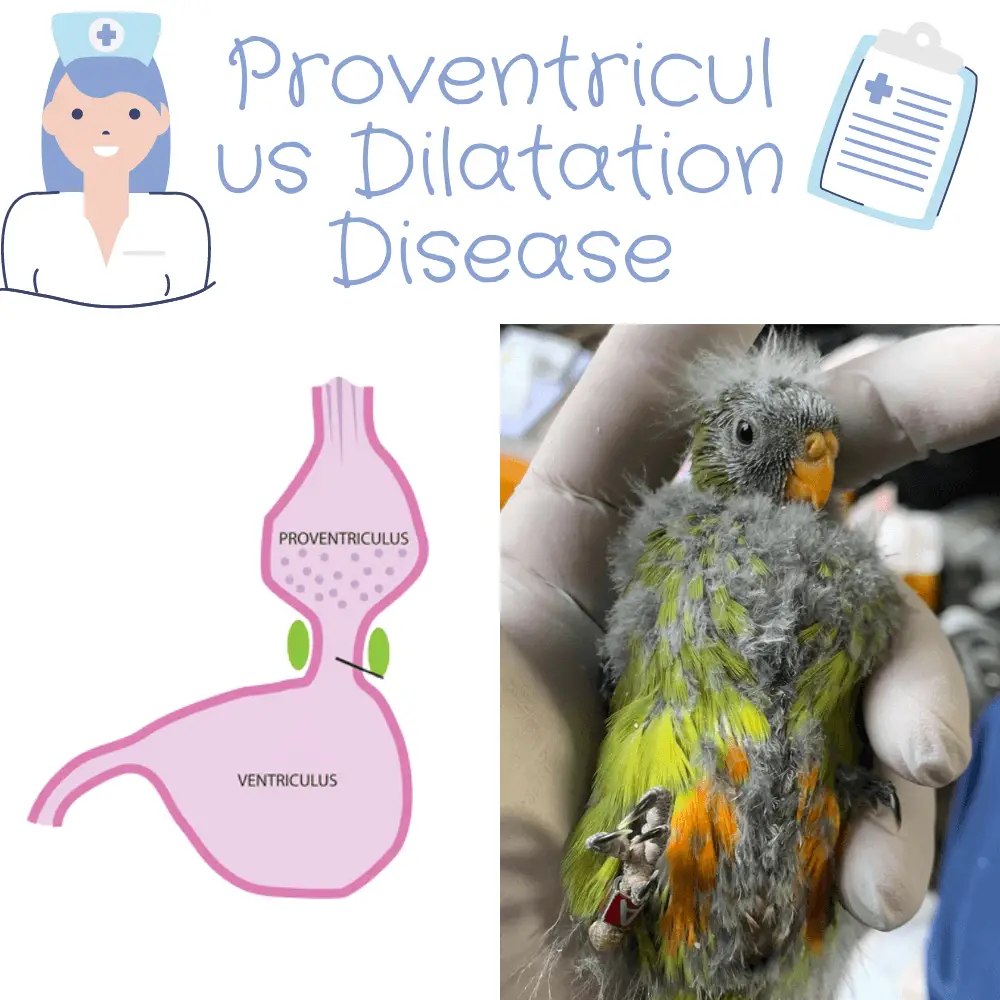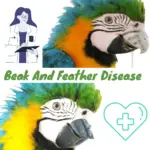
Proventriculitis, or PDD Proventriculus Dilatation Disease, is a deadly disease of slow evolution, responsible for nervous disorders and digestive dysfunctions consecutive to progressive destruction of nerve fibers. Known and feared by bird lovers since the 1970s, it has so far been described in more than fifty species of birds, including most of the Psittacidae (except until now the budgerigar), many small passerines (like the canary), toucans, raptors (including the peregrine falcon) and water birds like cranes and the Canada goose.
Proventriculitis or PDD
SOURCE:Animal Wonders Montana
Nervous and digestive symptoms
Symptoms, nervous and digestive, settle gradually. In the classical digestive form, the bird gradually becomes unable to properly evacuate its digestive tract and digest its food. This leads to an accumulation of food in the crop and a dilation of the stomachs (ventricle and proventricule), resulting in regurgitation, vomiting, the presence of undigested seeds in the droppings, and a progressive loss of weight in the animal.
The nervous form is characterized by loss of balance (sudden fall of the perch, especially at night), incoordination, abnormal head movements, convulsions, or the appearance of blindness.
The two clinical forms can possibly be combined. Death usually occurs after a few months of development.
A viral etiology had been suspected for a long time without its origin being known. In 2008, two teams (Kistler et al. And Honkavuori et al.) Independently identified in the US and Israel a new RNA virus, avian bornavirus, as the causative agent of this disease. Until now, only the mammalian bornavirus, known to cause encephalitis in horses, sheep, and sometimes other domestic animals, was known.
The symptoms are mainly linked to the immune-inflammatory reaction caused by the presence of the virus in nerve cells. The virus itself does not attack cells in the body.
Lots of healthy carrier birds
PDD Bird
This disease is characterized by an important healthy carrying, that is to say by a significant number of birds that were infected by the virus, which are contagious, but which do not necessarily develop the disease. Among the Psittacidae, the African Grey Parrot, the Cockatoo, the Amazons parrot more easily develop the disease while cockatiels are frequent healthy carriers.
Proventriculitis develops preferentially in dense populations of birds kept in an enclosed environment. Transmission takes place by ingestion of water or food contaminated with droppings, by inhalation of dried droppings dust, and probably directly by parents to young people because the virus is present in the ovaries and testes.
Incubation varies experimentally from 11 days to 2 months. An affected bird, however, can remain healthy for months or years and excrete the virus intermittently before developing symptoms.
A diagnosis is still complex to carry out
To remove doubt when you suspect this disease, it is necessary to carry out some additional examinations:
- Radiography: on radiographic examination, an increase in the size of the stomach is observed as well as the presence of gas in the intestinal loops. Although strongly suggestive of proventriculitis, this anomaly is not specific to this disease.
- Screening tests: now that we know the causative agent of this disease, the avian bornavirus, it is possible to develop screening tests.
These are of two types:
serology , which checks for antibodies that develop in the blood during infection with the virus, and
the PCR test , which makes it possible to directly search for the DNA of the virus in a sample taken from the bird.
These tests are under development and are not currently available in France. In any case, they do not yet allow a definite diagnosis to be made. Indeed, a positive serology does not differentiate a healthy carrier from a patient and the reliability of PCR tests depends on the actual presence of the virus in the sample. Samples taken from stool or samples of the oral mucosa are therefore not indicated because the virus is only present intermittently. The presence of viruses in the blood does not always seem to be detectable by a PCR test either. An interesting sampling site for PCR analysis would seem to be the basis of the pen, on condition that it is torn off as this leads to a nerve ending in which the virus is almost always present. Research is currently underway to try to develop a quick and reliable test
Histological analysis
In the absence of reliable screening tests, the safest method is still to take a small portion of digestive tissue and send it to a specialized laboratory to perform a histological analysis, i.e. an examination. microscopic examination of the tissues removed in order to highlight the characteristic lesions caused by the attack on the virus. Usually, a very small fragment of the crop is taken, a low-risk, superficial operation, which requires only brief anesthesia.
In conclusion, serology does not currently offer a simple and reliable test in order to make a diagnosis of clinical PDD on an individual. However, when it is available in France, this test will be easy to use and interesting for reviewing a population of birds, such as a flock in which we wish to eradicate PDD. However, the breeder should be aware that a large proportion of birds found to be positive will not develop clinical disease.
The most reliable diagnostic protocol for an individual therefore still consists of the moment of the histological examination of a crop biopsy.
Long-term treatment leads to real improvement
The main aim of the treatment is to reduce the symptoms because there is currently no medication to eliminate the virus. It must be maintained for several months to several years. Although a marked improvement is often observed, it is assumed until further notice that the birds remain chronically infected. The improvement usually occurs after fifteen days of administration. The evaluation criteria are weight gain, improvement in radiographic signs, and the gradual disappearance of lesions observed on repeated biopsies of the crop.
Treating the inflammation with nonsteroidal anti-inflammatory drugs (which are not cortisone-based) very often brings real relief to the sick bird. The decrease in intestinal mobility and chronic regurgitation should also be treated with digestive antispasmodics. Certain drugs used for Parkinson’s disease in humans can sometimes be used for nerve damage.
Finally, it is important to feed the bird with a highly assimilable food of liquid consistency, such as moistened extrudates or feeding porridge for young birds, because it thus brings real comfort and promotes weight gain. Affected birds often ingest foreign bodies, such as pieces of wood, presumably to try to relieve their digestive discomfort: the supplementation of food with vegetable fibers makes it possible to meet this need.




















